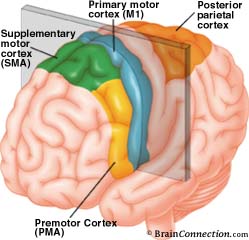Primary motor cortex
From Psy3242
| Line 13: | Line 13: | ||
The motor strip is highly topographical in its organization, and every part of the body is represented, though the relationship between cortical 'space' in the motor strip and body region is not proportionate. Body areas capable of fine motor control, such as the hands and fingers and the mouth area of the face, are over-represented, and there is under-representation of less 'movement-critical' regions such as the back and top of the head, the trunk or torso of the body, and the upper limbs. | The motor strip is highly topographical in its organization, and every part of the body is represented, though the relationship between cortical 'space' in the motor strip and body region is not proportionate. Body areas capable of fine motor control, such as the hands and fingers and the mouth area of the face, are over-represented, and there is under-representation of less 'movement-critical' regions such as the back and top of the head, the trunk or torso of the body, and the upper limbs. | ||
| - | + | [[Image:D 06 cr mou 1b.jpg]] | |
| - | + | ||
Revision as of 01:25, 25 April 2008
Functions
The primary motor cortex, also known as the motor strip, M1, F1, or Brodmann's Area 4, is one of the principal brain areas responsible for motor function and the execution of movements.
The primary motor cortex is located in the rear portion of the frontal lobe of the brain, before the central sulcus that separates the frontal lobe from the parietal lobe and along a bump called the precentral gyrus. M1 is only part of the complete motor cortex, which is also made up of the premotor area (PMA) and the supplementary motor area (SMA) of Area 6, but it includes the cortico-spinal and the cortico-bulbar pathways.
The motor strip is highly topographical in its organization, and every part of the body is represented, though the relationship between cortical 'space' in the motor strip and body region is not proportionate. Body areas capable of fine motor control, such as the hands and fingers and the mouth area of the face, are over-represented, and there is under-representation of less 'movement-critical' regions such as the back and top of the head, the trunk or torso of the body, and the upper limbs.
Interesting fact:
The motor cortex is responsible for movement, foot tapping, dancing and playing an instrument while the auditory cortex is responsible for the first stages of listening to sounds, and the perception and analysis of tones.


